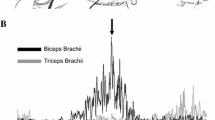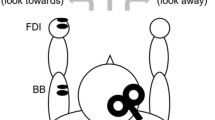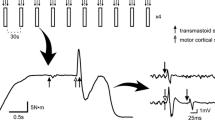Abstract
During strong voluntary contractions, activity is not restricted to the target muscles. Other muscles, including contralateral muscles, often contract. We used transcranial magnetic stimulation (TMS) to analyse the origin of these unintended contralateral contractions (termed “associated” contractions). Subjects (n = 9) performed maximal voluntary contractions (MVCs) with their right elbow-flexor muscles followed by submaximal contractions with their left elbow flexors. Electromyographic activity (EMG) during the submaximal contractions was matched to the associated EMG in the left biceps brachii during the right MVC. During contractions, TMS was delivered to the motor cortex of the right or left hemisphere and excitatory motor evoked potentials (MEPs) and inhibitory (silent period) responses recorded from left biceps. Changes at a spinal level were investigated using cervicomedullary stimulation to activate corticospinal paths (n = 5). Stimulation of the right hemisphere produced silent periods of comparable duration in associated and voluntary contractions (218 vs 217 ms, respectively), whereas left hemisphere stimulation caused a depression of EMG but no EMG silence in either contraction. Despite matched EMG, MEPs elicited by right hemisphere stimulation were ∼1.5–2.5 times larger during associated compared to voluntary contractions (P < 0.005). Similar inhibition of the associated and matched voluntary activity during the silent period suggests that associated activity comes from the contralateral hemisphere and that motor areas in this (right) hemisphere are activated concomitantly with the motor areas in the left hemisphere. Comparison of the MEPs and subcortically evoked potentials implies that cortical excitability was greater in associated contractions than in the matched voluntary efforts.




Similar content being viewed by others
References
Aranyi Z, Rosler KM (2002) Effort-induced mirror movements. A study of transcallosal inhibition in humans. Exp Brain Res 145:76–82
Armatas CA, Summers JJ, Bradshaw JL (1994) Mirror movements in normal adult subjects. J Clin Exp Neuropsychol 16:405–413
Brasil-Neto JP, Cammarota A, Valls-Sole J, Pascual-Leone A, Hallett M, Cohen LG (1995) Role of intracortical mechanisms in the late part of the silent period to transcranial stimulation of the human motor cortex. Acta Neurol Scand 92:383–386
Carson RG (2005) Neural pathways mediating bilateral interactions between the upper limbs. Brain Res Brain Res Rev 49:641–662
Carson RG, Riek S, Mackey DC, Meichenbaum DP, Willms K, Forner M, Byblow WD (2004) Excitability changes in human forearm corticospinal projections and spinal reflex pathways during rhythmic voluntary movement of the opposite limb. J Physiol 560:929–940
Cernacek J (1961) Contralateral motor irradiation—cerebral dominance. Its changes in hemiparesis. Arch Neurol 4:165–172
Chen R, Lozano AM, Ashby P (1999) Mechanism of the silent period following transcranial magnetic stimulation. Evidence from epidural recordings. Exp Brain Res 128:539–542
Chen R, Yung D, Li JY (2003) Organization of ipsilateral excitatory and inhibitory pathways in the human motor cortex. J Neurophysiol 89:1256–1264
Cohen LG, Bandinelli S, Sato S, Kufta C, Hallett M (1991) Attenuation in detection of somatosensory stimuli by transcranial magnetic stimulation. Electroencephalogr Clin Neurophysiol 81:366–376
Curschmann H (1906) Beitrage zur physiologie und pathologie der kontralateralen mitbewegungen. Deutsche Zeitschrift Nervenheilkunde 31:1–52
Datta AK, Harrison LM, Stephens JA (1989) Task-dependent changes in the size of response to magnetic brain stimulation in human first dorsal interosseous muscle. J Physiol 418:13–23
Diedrichsen J, Hazeltine E, Nurss W, Ivry R (2003) The role of the corpus callosum in the coupling of bimanual isometric force pulses. J Neurophysiol 90:2409–2418
Durwen HF, Herzog AG, Falk A, Calabrese P, Gehlen W (1997) Motorische spiegelphanomene; Spielgelbildliche mitbewegungen und mitaktivierungen. Neurol Rehabil 2:69–75
Ferbert A, Priori A, Rothwell JC, Day BL, Colebatch JG, Marsden CD (1992) Interhemispheric inhibition of the human motor cortex. J Physiol 453:525–546
Flament D, Goldsmith P, Buckley CJ, Lemon RN (1993) Task dependence of responses in first dorsal interosseous muscle to magnetic brain stimulation in man. J Physiol 464:361–378
Fuhr P, Agostino R, Hallett M (1991) Spinal motor neuron excitability during the silent period after cortical stimulation. Electroencephalogr Clin Neurophysiol 81:257–262
Gandevia SC (2001) Spinal and supraspinal factors in human muscle fatigue. Physiol Rev 81:1725–1789
Gandevia SC, Macefield VG, Bigland-Ritchie B, Gorman RB, Burke D (1993) Motoneuronal output and gradation of effort in attempts to contract acutely paralysed leg muscles in man. J Physiol 471:411–427
Gerloff C, Cohen LG, Floeter MK, Chen R, Corwell B, Hallett M (1998) Inhibitory influence of the ipsilateral motor cortex on responses to stimulation of the human cortex and pyramidal tract. J Physiol 510:249–259
Hess CW, Mills KR, Murray NM (1986) Magnetic stimulation of the human brain: facilitation of motor responses by voluntary contraction of ipsilateral and contralateral muscles with additional observations on an amputee. Neurosci Lett 71:235–240
Hortobagyi T, Taylor JL, Petersen NT, Russell G, Gandevia SC (2003) Changes in segmental and motor cortical output with contralateral muscle contractions and altered sensory inputs in humans. J Neurophysiol 90:2451–2459
Inghilleri M, Berardelli A, Cruccu G, Manfredi M (1993) Silent period evoked by transcranial stimulation of the human cortex and cervicomedullary junction. J Physiol 466:521–534
Kang Y, Kaneko T, Ohishi H, Endo K, Araki T (1994) Spatiotemporally differential inhibition of pyramidal cells in the cat motor cortex. J Neurophysiol 71:280–293
Kernell D, Hultborn H (1990) Synaptic effects on recruitment gain: a mechanism of importance for the input–output relations of motoneurone pools? Brain Res 507:176–179
Kim SG, Ashe J, Georgopoulos AP, Merkle H, Ellermann JM, Menon RS, Ogawa S, Ugurbil K (1993) Functional imaging of human motor cortex at high magnetic field. J Neurophysiol 69:297–302
Leocani L, Cohen LG, Wassermann EM, Ikoma K, Hallett M (2000) Human corticospinal excitability evaluated with transcranial magnetic stimulation during different reaction time paradigms. Brain 123:1161–1173
Liepert J, Dettmers C, Terborg C, Weiller C (2001) Inhibition of ipsilateral motor cortex during phasic generation of low force. Clin Neurophysiol 112:114–121
Maccabee PJ, Amassian VE, Cracco RQ, Cracco JB, Rudell AP, Eberle LP, Zemon V (1991) Magnetic coil stimulation of human visual cortex: studies of perception. Electroencephalogr Clin Neurophysiol 43(Suppl):111–120
Mayston MJ, Harrison LM, Stephens JA (1999) A neurophysiological study of mirror movements in adults and children. Ann Neurol 45:583–594
Meyer BU, Roricht S, Grafin von EH, Kruggel F, Weindl A (1995) Inhibitory and excitatory interhemispheric transfers between motor cortical areas in normal humans and patients with abnormalities of the corpus callosum. Brain 118:429–440
Muellbacher W, Facchini S, Boroojerdi B, Hallett M (2000) Changes in motor cortex excitability during ipsilateral hand muscle activation in humans. Clin Neurophysiol 111:344–349
Pascual-Leone A, Walsh V, Rothwell J (2000) Transcranial magnetic stimulation in cognitive neuroscience—virtual lesion, chronometry, and functional connectivity. Curr Opin Neurobiol 10:232–237
Pinneo LR (1961) The effects of induced muscle tension during tracking on level of activation and on performance. J Exp Psychol 62:523–531
Samii A, Canos M, Ikoma K, Wassermann EM , Hallett M (1997) Absence of facilitation or depression of motor evoked potentials after contralateral homologous muscle activation. Electroencephalogr Clin Neurophysiol 105:241–245
Shinohara M, Keenan KG, Enoka RM (2003) Contralateral activity in a homologous hand muscle during voluntary contractions is greater in old adults. J Appl Physiol 94:966–974
Singh LN, Higano S, Takahashi S, Kurihara N, Furuta S, Tamura H, Shimanuki Y, Mugikura S, Fujii T, Yamadori A, Sakamoto M, Yamada S (1998) Comparison of ipsilateral activation between right and left handers: a functional MR imaging study. Neuroreport 9:1861–1866
Sohn YH, Dang N, Hallett M (2003) Suppression of corticospinal excitability during negative motor imagery. J Neurophysiol 90:2303–2309
Stedman A, Davey NJ, Ellaway PH (1998) Facilitation of human first dorsal interosseous muscle responses to transcranial magnetic stimulation during voluntary contraction of the contralateral homonymous muscle. Muscle Nerve 21:1033–1039
Taylor JL, Gandevia SC (2004) Noninvasive stimulation of the human corticospinal tract. J Appl Physiol 96:1496–1503
Tinazzi M, Zanette G (1998) Modulation of ipsilateral motor cortex in man during unimanual finger movements of different complexities. Neurosci Lett 244:121–124
Tinazzi M, Farina S, Tamburin S, Facchini S, Fiaschi A, Restivo D, Berardelli A (2003) Task-dependent modulation of excitatory and inhibitory functions within the human primary motor cortex. Exp Brain Res 150:222–229
Todor JI, Lazarus JA (1986) Exertion level and the intensity of associated movements. Dev Med Child Neurol 28:205–212
Wassermann EM, Fuhr P, Cohen LG, Hallett M (1991) Effects of transcranial magnetic stimulation on ipsilateral muscles. Neurology 41:1795–1799
Wassermann EM, Pascual-Leone A, Hallett M (1994) Cortical motor representation of the ipsilateral hand and arm. Exp Brain Res 100:121–132
Ziemann U, Ishii K, Borgheresi A, Yaseen Z, Battaglia F, Hallett M, Cincotta M, Wassermann EM (1999) Dissociation of the pathways mediating ipsilateral and contralateral motor-evoked potentials in human hand and arm muscles. J Physiol 518:895–906
Zijdewind I, Kernell D (2001) Bilateral interactions during contractions of intrinsic hand muscles. J Neurophysiol 85:1907–1913
Zwarts MJ (1992) Central motor conduction in relation to contra- and ipsilateral activation. Electroencephalogr Clin Neurophysiol 85:425–428
Acknowledgments
This research was supported by the National Health and Medical Research Council (Australia). I. Zijdewind was supported by a travel grant of The Netherlands Organization for Scientific Research (NWO).
Author information
Authors and Affiliations
Corresponding author
Rights and permissions
About this article
Cite this article
Zijdewind, I., Butler, J.E., Gandevia, S.C. et al. The origin of activity in the biceps brachii muscle during voluntary contractions of the contralateral elbow flexor muscles. Exp Brain Res 175, 526–535 (2006). https://doi.org/10.1007/s00221-006-0570-z
Received:
Accepted:
Published:
Issue Date:
DOI: https://doi.org/10.1007/s00221-006-0570-z




